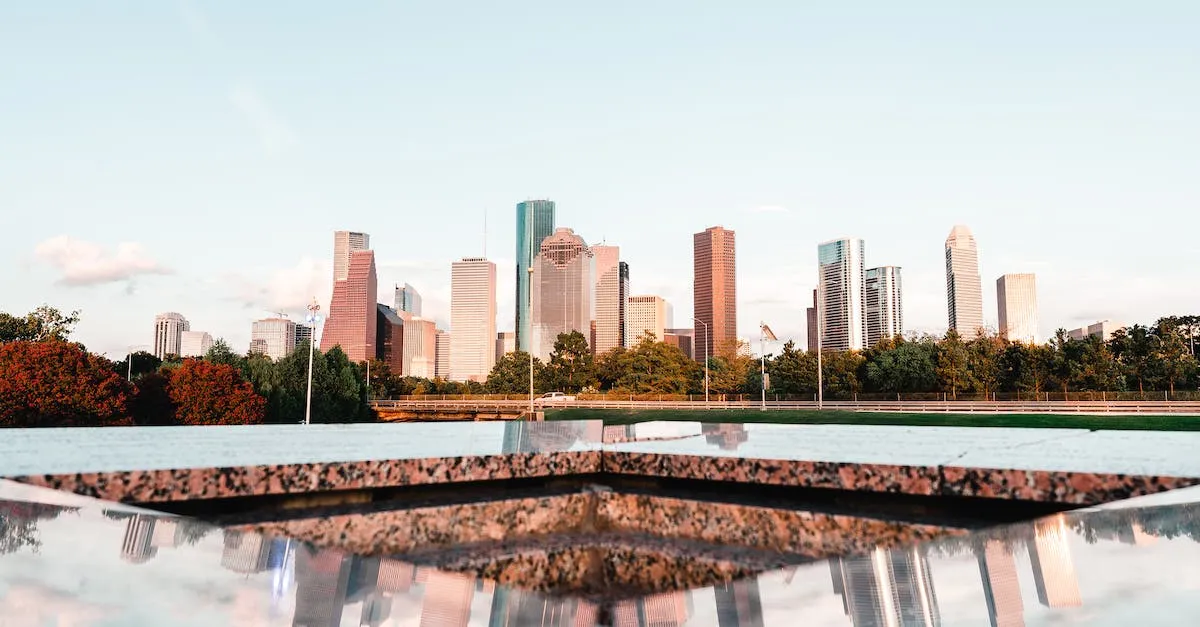The Biome Of Houston, Texas
Houston’s climate and geography make it home to a unique biome that many may not expect to find in Texas. If you’re short on time, here’s a quick answer: Houston is located in the humid subtropical climate zone, characterized by hot, humid summers and mild winters.
In this approximately 3000 word article, we will dive into detail about Houston’s climate, native vegetation, wildlife, and how development has impacted the natural biome found in the region. We will look at the characteristics that define Houston’s biome, how it compares to other biomes in the United States, and the efforts to preserve pockets of native biome habitat within the city.
Houston’s Climate
Houston, Texas is known for its unique climate that is characterized by hot and humid summers and mild winters. The city experiences a subtropical climate due to its proximity to the Gulf of Mexico. The climate in Houston is influenced by various factors such as temperature, precipitation, and the occurrence of hurricanes and tropical systems.
Let’s explore these factors in more detail.
Temperature and Precipitation
Houston has a warm and humid climate throughout the year. Summers are hot with average temperatures ranging from the mid-90s to the low 100s Fahrenheit (35-40 degrees Celsius). Winters are mild with average temperatures ranging from the 60s to the 70s Fahrenheit (15-25 degrees Celsius).
The highest recorded temperature in Houston was 109°F (43°C) in 2000, while the lowest recorded temperature was 5°F (-15°C) in 1930.
Precipitation in Houston is abundant, with an average annual rainfall of about 50 inches (1270 mm). The city experiences rain throughout the year, with the wettest months being May and June. Thunderstorms are common in Houston, especially during the summer months, and can bring heavy rainfall, lightning, and strong winds.
Hurricanes and Tropical Systems
Houston is located in a region that is prone to hurricanes and tropical systems. The city is vulnerable to the impacts of these weather events due to its proximity to the Gulf of Mexico. Hurricanes are powerful tropical cyclones that can bring strong winds, heavy rain, storm surges, and flooding.
The hurricane season in the Atlantic Basin, which includes the Gulf of Mexico, runs from June 1st to November 30th.
Over the years, Houston has experienced several devastating hurricanes. One of the most notable hurricanes to hit the city was Hurricane Harvey in 2017. It caused widespread flooding and significant damage to homes, infrastructure, and the economy.
The city has since implemented various measures to improve its resilience and preparedness for future hurricanes and tropical systems.
For more information on Houston’s climate, you can visit the National Weather Service Houston-Galveston website. They provide up-to-date weather forecasts, warnings, and valuable information about the climate in the Houston area.
Native Vegetation
Houston, Texas is home to a diverse range of native vegetation, which plays a crucial role in maintaining the balance of the city’s unique biome. From forests to grasslands and wetlands, each ecosystem contributes to the overall health and well-being of the region.
Forests
Houston is fortunate to have several forested areas, providing important habitats for numerous plant and animal species. The most prominent forest type found in the region is the Piney Woods, characterized by its dense pine trees and hardwoods such as oak and hickory.
These forests not only serve as homes for wildlife but also act as natural filters, improving air and water quality.
The Houston Arboretum and Nature Center is a great place to explore and learn about the native forests of the area. With its network of trails, visitors can experience the beauty and tranquility of the Piney Woods firsthand.
Grasslands
Grasslands are another important component of Houston’s native vegetation. These open areas are characterized by a variety of grasses and wildflowers that provide food and shelter for a diverse range of species.
The Katy Prairie Preserve is a prime example of a grassland ecosystem in the Houston area.
The Katy Prairie Preserve is not only home to a wide array of plant and animal life but also serves as an important stopover for migratory birds. Visitors can witness the beauty of the grasslands and observe the unique wildlife that calls this area home.
Wetlands
Wetlands are vital ecosystems that provide numerous ecological services, including water filtration, flood control, and habitat for a wide range of species. Houston boasts a variety of wetland habitats, including marshes, swamps, and bayous.
One iconic wetland area in Houston is the Armand Bayou Nature Center. This expansive wetland preserve is home to an abundance of plant and animal life, including the majestic bald eagle. Visitors can explore the wetlands through guided tours and learn about the importance of wetland conservation.
It is important to note that preserving and protecting these native vegetation areas is crucial to maintaining the biodiversity and ecological balance of Houston’s biome. By supporting local conservation efforts and visiting these natural areas, individuals can contribute to the sustainability of the region’s native vegetation.
Wildlife
The city of Houston, Texas is not only known for its vibrant culture and booming economy, but also for its rich and diverse wildlife. The city is home to a wide variety of mammals, birds, reptiles and amphibians, and aquatic life, making it a haven for nature enthusiasts and wildlife lovers.
Mammals
Houston is home to several mammal species, both native and introduced. One of the most iconic mammals in the area is the white-tailed deer, which can often be seen grazing in parks and green spaces. Other mammals commonly found in Houston include raccoons, opossums, and armadillos.
These animals have adapted to urban environments and can be spotted in residential areas as well as natural habitats.
Birds
Houston is a birdwatcher’s paradise, with over 300 bird species documented in the area. The city’s diverse ecosystems, including wetlands, forests, and coastal areas, attract a wide range of bird species throughout the year.
From colorful songbirds like the Northern Cardinal and the Painted Bunting, to majestic raptors such as the Bald Eagle and the Red-tailed Hawk, Houston offers a birding experience like no other.
Reptiles and Amphibians
The warm climate of Houston provides an ideal habitat for reptiles and amphibians. Snakes, turtles, and lizards are commonly found in the city and its surrounding areas. The American alligator, a reptile native to Texas, can also be spotted in freshwater areas such as ponds and bayous.
As for amphibians, frogs and toads are abundant in Houston, especially after rainfall when they come out to breed.
Aquatic Life
With its proximity to the Gulf of Mexico and various freshwater sources, Houston boasts a diverse range of aquatic life. The city’s bayous and rivers are home to species such as catfish, bass, and sunfish, making it a popular destination for fishing enthusiasts.
In addition, the coastal areas near Houston provide a habitat for marine animals, including dolphins, sea turtles, and various species of fish.
For more information about the wildlife in Houston, you can visit the Houston Audubon Society or the Texas Parks and Wildlife Department.
Impact of Development on the Biome
As Houston, Texas continues to grow and develop, the impact on its biome becomes increasingly significant. The rapid urbanization and expansion of infrastructure have led to a number of challenges for the local ecosystem.
Loss of Habitat
One of the most significant consequences of development in Houston is the loss of habitat for native wildlife. As land is cleared for construction, natural habitats such as forests, wetlands, and prairies are destroyed.
This loss of habitat has a direct impact on the biodiversity of the area, as many species are unable to adapt to the rapidly changing environment. According to a study conducted by the Houston Advanced Research Center, over the past decade, Houston has lost more than 24,000 acres of natural habitat.
Fragmentation
The fragmentation of the biome is another consequence of development. As urban areas expand, they create barriers that separate once contiguous habitats. This fragmentation can disrupt migration patterns, limit gene flow between populations, and isolate species, leading to a decrease in genetic diversity and an increased risk of extinction.
It also affects the movement and survival of wildlife, as they are forced to navigate through urban areas, encountering roads, buildings, and other human-made obstacles.
Invasive Species
The introduction and spread of invasive species is a significant concern in Houston’s biome. As development occurs, it provides opportunities for non-native species to establish themselves and outcompete native species for resources.
Invasive species can disrupt the balance of the ecosystem, negatively impacting native plants and animals. A well-known example in Houston is the spread of the Chinese tallow tree, which has become a dominant species in many areas, outcompeting native vegetation and reducing biodiversity.
Light and Noise Pollution
Development in Houston has also led to an increase in light and noise pollution, which can have adverse effects on the local biome. Artificial lights from buildings and streetlights can disrupt natural light cycles, affecting the behavior and reproduction of nocturnal animals.
Noise pollution from traffic, construction, and other human activities can also disturb wildlife, causing stress and interfering with communication and foraging behaviors.
It is important to consider the impact of development on the biome and take steps to mitigate these effects. Conservation efforts, such as the preservation of green spaces, the implementation of wildlife corridors, and the control of invasive species, can help maintain the ecological balance in Houston’s rapidly changing environment.
Preservation Efforts
Preserving the unique and diverse ecosystem of Houston, Texas is of utmost importance to both the local community and environmental organizations. Through various preservation efforts, the aim is to protect the natural areas, wildlife corridors, and implement regulations and incentives to ensure the sustainability and conservation of the biome.
Protected Natural Areas
Houston is home to several protected natural areas that serve to preserve the region’s biodiversity and ecological balance. These areas, such as the Armand Bayou Nature Center and the Brazos Bend State Park, provide a safe haven for native plant and animal species.
These protected areas not only offer recreational opportunities for residents and visitors but also serve as outdoor classrooms for educational programs and research initiatives.
Wildlife Corridors
Wildlife corridors are an essential component of preserving the biome of Houston. These corridors are designated pathways that connect fragmented habitats, allowing animals to move freely between different areas.
By creating and maintaining these corridors, Houston ensures that wildlife populations can thrive and maintain genetic diversity. It also helps prevent isolated populations from becoming extinct and allows for the migration of species in response to environmental changes.
Regulations and Incentives
To further protect and preserve the biome of Houston, regulations and incentives have been implemented. These include zoning regulations that limit development in sensitive areas, such as wetlands and floodplains, and encourage responsible land use practices.
In addition, incentives such as tax breaks and grants are provided to landowners who actively engage in conservation efforts, such as implementing sustainable farming practices or preserving natural habitats on their properties.
By combining these preservation efforts, Houston is able to maintain its unique and diverse ecosystem for future generations to enjoy. The collaboration between the local community, environmental organizations, and governmental bodies is crucial in ensuring the long-term sustainability and conservation of the biome.
Conclusion
In conclusion, while Houston has experienced massive growth and development over the past century, remnants of the native humid subtropical biome can still be found scattered throughout the metropolitan region. Pockets of coastal prairie, bottomland forests, wetlands, and other habitat provide a home for many species of plants and animals. Ongoing conservation efforts aim to preserve these natural areas and connect them into a cohesive network that allows wildlife to thrive alongside Houston’s human population.








